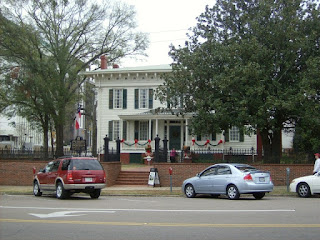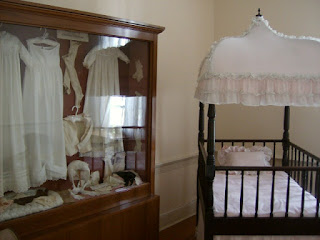Preparing for Deer Season in Alabama takes a lot of hard work in the Alabama heat. First there's the bush hogging, then the planting.....hoping for rain, in what is usually the dry time of the year and alot of praying that the hard work paid off and you can draw the herd to your land, not your neighbor's. Steve, Brock and Kevin worked very hard. I am posting this video on what Steve calls "Redneck Christmas Eve" - the night before deer season 2012. Good luck, Guys! I hope you do well tomorrow!
Hi and Welcome!
This, It Happens in Alabama blog, is written by me, Janet Kynard. I am the Founder/President of It Happens in Alabama. My posts are based on real life experiences and personal opinions and are meant to be used as a reference when planning outings, for entertainment purposes and for keeping up with activities, happenings and events in Alabama. I hope you enjoy. Please feel free to leave feedback and to share.
Monday, December 31, 2012
Sunday, December 30, 2012
How-To Fillet a Fish with and Electric Knife
Fossils in Alabama
Thursday, December 20, 2012
A Shrine of the Time

I
had the unique experience of visiting the First White House of the Confederacy and getting
a personal tour from Henry
Paul Howard, a Civil War re-enactor and
the First White House Tour guide. With his background, he is the perfect person
to show you around and answer all of your questions. The First White House is
located in Montgomery, Alabama,
just across Washington Ave, from the Alabama State Capital,
in front of the Alabama
Department of Archives and History. The
First White House was voted by followers of It Happens in
Alabama as one of the top 110 attractions and Must-See Places in Alabama Louisiana Japan
The
First White House of the Confederacy was the Executive Residence of President
Jefferson Davis and family while the capital of the Confederacy was in Montgomery Richmond , Virginia
The
house is set up as a shrine to Jefferson Davis and his family. The furniture in
Jefferson ’s bedroom, as an
agreement between the Association, Varina Davis (wife) and Margaret Davis
(daughter) is set to the exact floor plan as it existed when he was alive. Most
of the furniture in the house was donated by Mrs. Davis and, after her death,
her daughter. The house has the bed Jefferson slept in and the bed in
which Mrs. Davis Died.
I would love to live in this house, exactly as it is
today, even with the need for a “necessary house” (restroom and kitchen not
being in the main house, in case of fire). It is a decorator’s dream, from the
placement of furniture in the large rooms creating conversation areas to the
way pictures are grouped on the walls creating a story.
There were many items I
found particularly interesting like the huge grand piano in the first parlor
that is still playable, a silver water cooler in the dining room that was
buried for 10 years to keep it from being taken by the Union soldiers, huge
chandeliers in every room, the floor to ceiling infinity mirrors, and the use
of pocket doors.
Back in the day there was such a thing called a “door fee” and
people were taxed on the number of doors in their house, so the use of pockets
doors reduced this cost because they were considered walls. In the double
doorways, pocket doors gave the house a huge open feeling between the parlors
and the main dining room.
I learned
why the chairs in the house are lower to the floor, than what we use today.
It’s because no self respecting Southern Lady would ever show her feet or
ankles show. They worn their dresses to the ground and the low chairs kept them
from rising up when sitting down. Tables with mirrors underneath, at floor
level, were commonly seen in the entrance way of houses for ladies to check
their petticoats, when they arrived.
I enjoyed the relic room which was filled
with many one of a kind special items. They even had the handmade flag that
draped Jefferson Davis’ casket. The nursery is a must see for and expecting or
new mother! You’ll want to give yourself plenty of time to see everything. I
found myself going back to rooms and displays two and three times!
Thursday, December 13, 2012
Ever wondered what is beneath the bark of a tree?
by: Janet Kynard
When asked what is beneath the bark of a tree, most people would answer “wood”. Some may say ’bark beetles” or “insects”, but the best person to answer this question is Corey Worden, owner of Beneath The Bark Chainsaw Carvings. His answer would be “anything you want it to be”. Corey, originally from Connecticut, lives in Titus, Alabama and is the proud father of two girls ages two and six - Skyler and Mackinzie. He has been a chainsaw carver for 16 years. His big break came when he received a request to perform at the Bethlehem Fair and the rest was history. He credits his success to being blessed with good depth perception and the ability to gage proportions. His favorite medium is wood because “it’s 50% destruction and 50% creation”. The majority of his work is commissioned, so you can have him make a special work of art especially for you. The cost starts around $250 for a 2 foot to 2.5 foot creation. Corey has now been commissioned to carve a life size carving of the legendary Alabama football coach Paul “Bear” Bryant.
Corey carves on the lawn next to Shaylee’s convenient store on Hwy 231 north, in Titus, Alabama, approximately 11 miles north of Wetumpka. It is not unusual to see a crowd gathering to take pictures and watch him work.
To get your very special carving, you can contact Corey Worden at 334-567-5718 or by email at beneaththebark.cw@gmail.com. He is also available for custom on site carvings, shows and events. This year he carved at the Alabama National Fair in Montgomery, Alabama, October 5-14-2012.
Tuesday, December 11, 2012
Off the Beaten Path and into History
By: Janet Kynard, Founder/President It Happens in Alabama
My husband, Steve, had wanted
to take me to Confederate Memorial Park for
some time and we finally made it there on Saturday. It was well worth the
visit! Confederate Memorial
Park Marbury , Alabama Montgomery Alabama
 |
| Confederate Research Library |
 |
Left to Right: Commander Gary Carlyle, Vann Royal, Janet Kynard - IHIA,
Division Historian and Past Commander Leonard Wilson
|
We had a wonderful visit at the Confederate Research Library where books are not shelved using the Dewey Decimal System, but are arranged alphabetically by topic. We were greeted by Leonard Wilson, a past Commander and the Division Historian. You really must go see him! He has so many wonderful stories. I can imagine sitting in an old rocking chair on a porch, sipping sweet tea and listening to his stories all afternoon. I also had the pleasure of meeting Commander Gary Carlyle and Vann Royal, who had just attended the Children’s Christmas program at the
Museum and Gift Shop Bricks from the dismantled buildings
The Museum had so many
displays that we were in there for over an hour! It was very interesting and
told the story of the Alabama
 |
| Matthew Brady lantern slide of Gen. Robert E. Lee |
I found it interesting that so many men returned from the war as amputees and the state of
Cemetery One Sasanqua Camellia
When visiting Cemetery One, I was amazed at the number
of men who died in February, not all in the same year, but the same month. This
has me puzzled. What went on in February? Was it the cold or just a
coincidence?
Outside of Cemetery Two, stood one of the most
gorgeous Sasanqua Camellias I have ever seen. It was in full bloom. The park is
also home to the second largest Poplar tree in Alabama
Entrance to Cemetery Two View from Cemetery Two
Cemetery Two was built after Cemetery One was full and
contains the graves of 224 veterans, including 15 wives and widows. It was
built on the top of a hill and is a very peaceful spot with a great view of the
rolling land below. It is as if the soldiers are still keeping watch over Alabama
There is still so much more
to see here and a great walking trail with markers where the 22 buildings once
stood. My visit sparked my curiosity about Alabama Alabama
If you like this article, please share it with your friends and check out the It Happens in Alabama web site for more neat content, videos and what's happening in Alabama.
Thank you for reading this post. Please leave a comment.
Subscribe to:
Comments (Atom)














